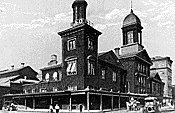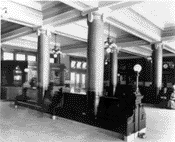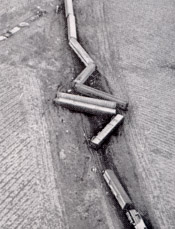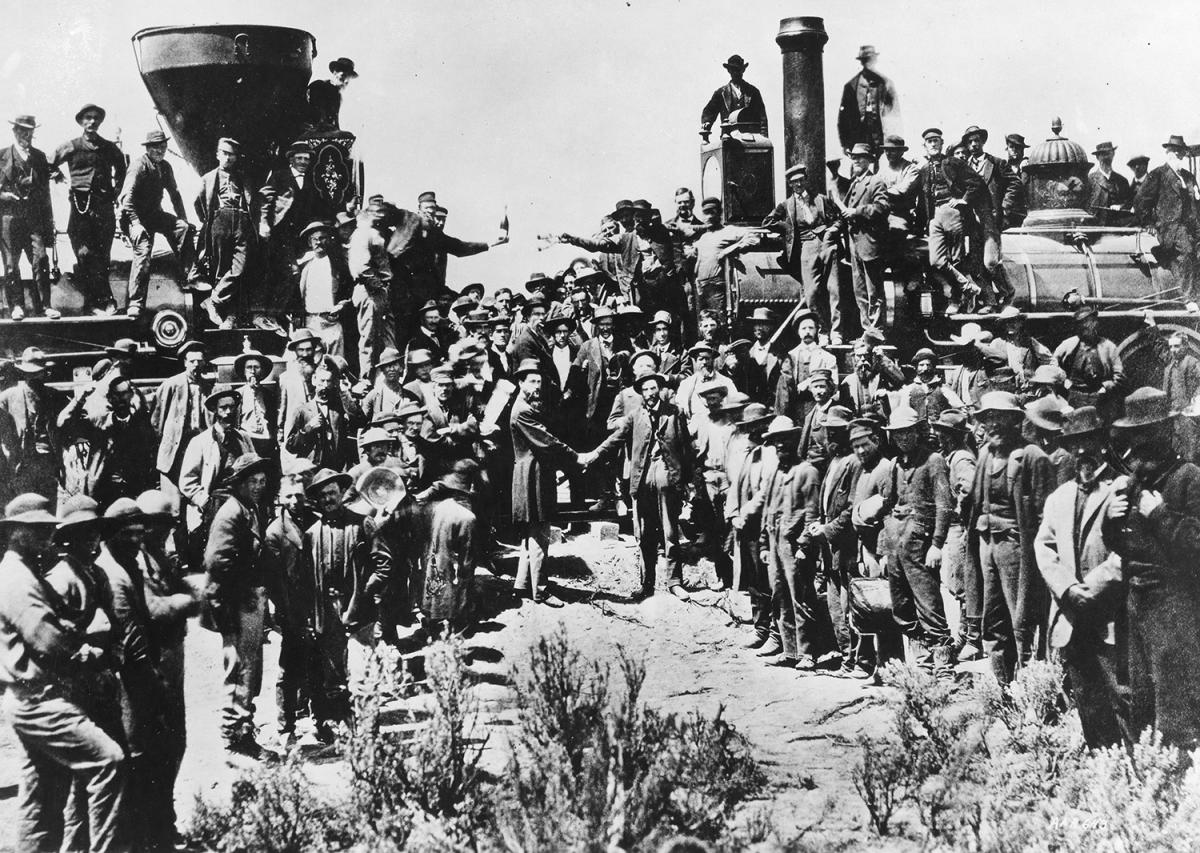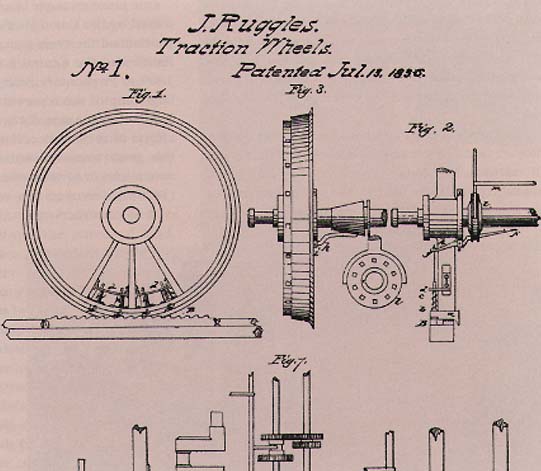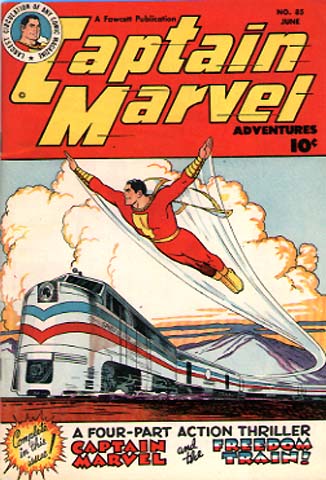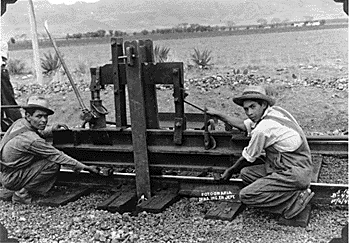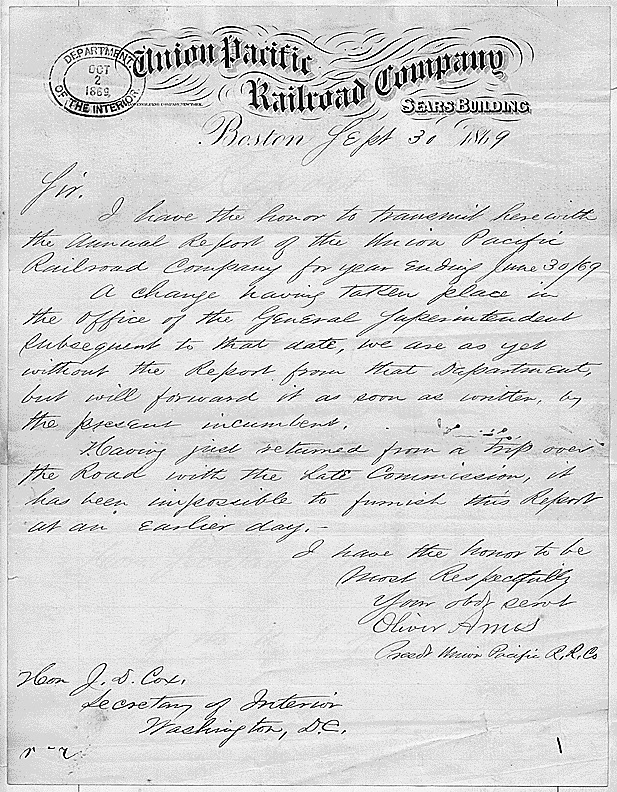
Riding the Rails Up Paper Mountain
Researching Railroad Records in the National Archives
Spring 1997, Vol. 29, No. 1
By David A. Pfeiffer
Railroads have played an enormous role in American history, particularly in the saga of the settlement of the American West in the nineteenth century. Railroads have also played a major part in military operations and civilian supply activities during wartime. The growth of interstate commerce and mass transportation is mostly attributable to railroads. The National Archives and Records Administration (NARA) has a large volume of textual records, maps, still photographs, and motion pictures relating to railroads. Significant information about railroads is contained in more than fifty record groups comprising hundreds of series. This article highlights several examples of textual railroad records.
The American research public is slowly discovering the value of railroad records. Reference requests at NARA have been increasing over the years as more records relating to railroads have become available and as researchers have become aware of them. Many of these researchers are interested in gathering information either on a particular railroad or on a specific geographic area. The researchers include railroad buffs who are interested in the history of a railroad, model railroaders who request railroad track plans, attorneys involved in land-use litigation who need to determine title to parcels of land that were owned by a railroad, historic preservationists who are interested in construction details for railroad structures such as passenger and freight stations, genealogists interested in tracing ancestors who were railroad employees or involved in railroad accidents, and historians interested in the U.S. government's control and use of the railroads during wartime.
Railroad Valuation Records
Some of the most popular records among model railroaders, historic preservationists, railroad history buffs, and even genealogists are the railroad valuation records of the Interstate Commerce Commission (ICC). These records provide documentation pertaining to the railroads of the United States from their beginning until the 1960s. Most valuation records were created between 1915 and 1920 by the ICC and railroad engineers who undertook a massive project to inventory almost every aspect of the U.S. railroad system for the purpose of determining a net worth for each railroad. This value was then used to calculate passenger and freight rates.
The valuation records in NARA's custody total approximately eleven thousand cubic feet and are divided into two general subdivisions. Basic valuation records provide information about the railroad facilities existing at a particular location, the land owned by the railroad and how it was acquired, and the land adjacent to railroad property during the period 1915–1920. Periodic engineering updates follow changes in facilities and rolling stock held by a railroad from the period of the basic valuation to the 1960s.(1)
The valuation records generally comprise land, engineering, and accounting final reports and supporting documentation, including field notes and maps. A typical example of the valuation records are the records pertaining to the Baltimore and Ohio (B&O) Railroad's Camden Station in Baltimore, Maryland. The valuation maps, which are very popular with model railroaders, include detailed track plans for Camden Yards and the immediate vicinity. Each track map (a twenty-four-by-fifty-four-inch blueprint) covers one mile of track. The maps include the area between Camden Station and Bailey's Roundhouse at the southern end of the yard and show the location of railroad structures on the right-of-way.(2)
The engineering field notes for Camden Yards contain construction details of the station, the warehouse building, the roundhouse, and other railroad structures in the yard. The engineering notes include drawings and photographs including views of the interior and exterior of Camden Station, the train shed, the freight office, and the warehouse.(3)
The land field notes include the names of the owners and the value of the land adjacent to the railroad right-of-way around 1915. Finally, the land acquisition schedules list the landowners from whom the B&O acquired the station and yards, giving the name of the landowner, the date and cost of acquisition, type of instrument (such as lease grant, right-of-way deed or condemnation), and the parcel of land involved. The schedules are particularly useful for genealogists, provided they know the geographic location where their ancestor resided.(4)
Another series of records in the ICC railroad valuation records are the railroad inspection reports of 1939–1942. These reports include a typed summary of the ICC inspection of railroad facilities and often photographs of railroad structures and equipment. The report for the Alton Railroad contains an unusually large number of photographs.(5)
Railroad Accident Reports
Railroad accident reports hold particular of interest for genealogists and railroad historians. The National Archives has custody of railroad accident reports for the period 1911–1984 in the records of the Interstate Commerce Commission and the Federal Railroad Administration.
One of several series of accident reports are the "Reports of Investigations of Railroad Accidents, 1958–1964," prepared by the ICC, in the records of the Federal Railroad Administration. In this series the accident reports are typed summaries that average ten pages in length and include photographs and track diagrams. Railroad Accident Investigation Report #3931 describes the collision of a Chicago, Rock Island, and Pacific passenger train with a motor-grader near Beech, Iowa, on November 16, 1961. This collision resulted in injuries to 110 people, including 82 passengers and the driver of the motor-grader. The crash was caused "by a motor-grader being driven onto a rail-highway grade crossing immediately in front of an approaching train."(6) The report includes a discussion of the location of accident, method of operation, description of the accident, the motor vehicle and driver, and the cause of the accident.
The largest series of records (106 cubic feet) relating to railroad accidents are the "Accident Investigation Report Files, 1969–84," in the records of the Federal Railroad Administration. These records comprise case files containing much more information than the published accident reports. Files typically include the factual accident report, copies of the railroad rules and regulations that relate to the accident, other railroad publications including timetables, statements of witnesses to the accident, railroad test and inspection data reports, railroad bulletins and notices, railroad investigation reports, and drawings and photographs of the wreckage at the accident site.(7)
Annual Reports of Railroad Companies
The annual reports submitted by railroad companies are useful to researchers interested in the history of railroads. The National Archives has custody of annual reports from 1862 to 1963 in the records of the Department of the Interior, the Commissioner of Railroads, and the Interstate Commerce Commission. The secretary of the interior was responsible for collecting annual reports from the Union Pacific, Central Pacific, Northern Pacific, Atlantic and Pacific, and the Southern Pacific railroads, companies that were receiving aid from the government between 1862 and 1878.
One prime example of an annual report is that submitted by the Union Pacific Railroad in 1869, which proclaimed the connecting of the rails of the Union Pacific and the Central Pacific Railroad on May 10, 1869, at Promontory, Utah. In his letter at the beginning of the report the president of the Union Pacific, Oliver Ames, declared that "the extraordinary efforts of these two companies in pushing forward this great trans-continental railway to completion seven years in advance of the time prescribed by law, (1876) has resulted in a very heavy increase in the cost of construction; yet the rapid development of the mining and agriculture districts, consequent upon the cheap and easy transportation thus afforded, will be of great advantage to our whole country and hence more than compensate the government for the subsidies granted."(8) The report also includes lists of the names of the board of directors and the stockholders. The report of the chief engineer describing the construction of the railroad and the report of the operating department of the railroad are also prominent in the annual report. This annual report is found in the records of the Department of the Interior, Lands and Railroads Division, "Railroad Packages, 1849–1901."
The Lands and Railroads Division handled business of the Office of the Secretary of Interior concerning disposal of public lands, land grants, private land claims, and other functions as provided by the Homestead Act and other laws. The division also handled matters concerning the Pacific and land grant railroads, such as aiding the construction of railroads by federal land grants. The Railroad Packages, dating mostly from 1862 to 1881, are chiefly letters received from the President, the Commissioner of the General Land Office, and other federal officials concerning land grant and Pacific railroads. Annual reports from the land grant railroads are also included.(9)
The records of the commissioner of railroads include railroad annual reports for the period 1878 to 1904. These reports were submitted by railroads whose tracks lay west, north, or south of the Missouri River and to which the United States had granted loans, subsidies, or land.(10)
The ICC records include the annual reports of all common carriers for the period 1887 to 1963. These reports were submitted on an ICC standard form, are usually twenty to forty pages in length, and typically include the identity of the respondent, the comparative general balance sheet assets and liabilities, investment in road and equipment, income and profit and loss accounts, railway operating revenues and expenses, income and rents, employees and their compensation, important changes during the year, and description of equipment.(11)
Those interested in the history of railroad technology should be aware of the existence of the invention patent application files. The National Archives currently has custody of these files dating from 1836 through 1918. The earlier patents and their models were destroyed in a fire at the Patent Office building in 1836. The National Archives also has custody of the reconstructed patent drawings from the period 1790-1836.
The early invention patent application files are jacketed. The outside cover gives such information as the patent application number; the name of the inventor and his or her place of residence; name of invention; dates of receipt of the petition; notation of the existence of affidavit, specifications, drawings, and model; cash fee; name of patent examiner; and date the invention was patented. The inside of the typical jacket contains the petition, affidavits, drawings, specifications, and related correspondence.
One of the foremost examples of invention patents relating to railroads is the Locomotive Steam Engine for Rail and Other Roads, patented by John Ruggles of Thomaston, Maine, dated July 28, 1836. This patent was Invention Patent #1, the first patent issued after the fire. This particular patent jacket contains printed specifications and drawings. In the specifications, Ruggles maintains that "I . . . have invented a new and useful improvement or improvements on locomotive-engines used on railroads and common roads by which inclined planes and hills may be ascended and heavy loads drawn up the same with more facility and economy than heretofore, and by which the evil effects of frost, ice, snows, and mud on the rail causing the wheels to slide are obviated." In order to prevent sliding, Ruggles used a check rail and retreating cogs operated by springs on the rims of the locomotive wheels.(12)
Another important invention patent in the history of railroads is the patent for railroad car couplings by Eli H. Janney of Alexandria, Virginia, issued on April 25, 1873 (Invention Patent #138,405). This jacket includes the petition, handwritten specifications, correspondence relating to the patent, and the printed drawings. The invention was a coupler that combined a rotary hook and catch mechanism with a guard-arm. Janney remarks that "the advantages of the described construction are numerous. It will couple readily under all circumstances if one of the hooks is open, but will not if both are closed. It is adapted for use upon cars of different heights. It has no lateral or longitudinal play, but moves freely vertically. It is impossible for it to become uncoupled unless the cars leave the track."(13)
American Heritage Foundation Freedom Train
Railroad historians may also be interested in the records of the American Heritage Foundation (AHF) concerning the Freedom Train, one of the greatest patriotic campaigns in American history. The Freedom Train tour was designed as a traveling exhibit of historic documents highlighting the evolution of the American freedom. It consisted primarily of original landmark documents of American history, including Jefferson's draft of the Declaration of Independence, Washington's Farewell Address, the Mayflower Compact, and Lincoln's Gettysburg Address. The thirty-seven-thousand-mile rail tour of the United States, taken during 1947–1949, covered every state in the Union and visited 322 communities. The tour ended in Washington during the January 1949 inauguration of President Truman. The train consisted of the "Spirit of 1776" locomotive, which pulled seven white cars with red, white, and blue stripes running the length of the train. The Freedom Train project was sponsored by the U.S. Attorney General and run by the American Heritage Foundation.(14) Entertainers such as Bing Crosby, Irving Berlin, and the Andrew Sisters donated their services for the campaign. In fact, Berlin's song "The Freedom Train" was sung and recorded by Bing Crosby and the Andrew Sisters.(15)
The Freedom Train files and other records of the American Heritage Foundation were donated to the National Archives and Records Administration. These records include Freedom Train activity and promotional reports and correspondence, progress reports, and the AHF records relating to the Freedom Train. There are newspaper and magazine articles, postcards, studies on the impact of the Freedom Train, photographs of the documents of freedom, and press releases in these files. There is also a volume entitled Heritage of Freedom: The History and Significance of the Basic Documents of Liberty, by Frank Monaghan, and a Captain Marvel comic book containing a "four-part action thriller" called "Captain Marvel and the Freedom Train."
United States Railway Mission to Mexico
The records of the United States Railway Mission to Mexico, located in the records of the Office of Inter-American Affairs (OIAA), are of great interest to World War II historians who study the role of the railroads during the war. The mission, sponsored by the Institute of Inter-American Transportation, a subsidiary of the OIAA and headed by Nelson A. Rockefeller, was sent to Mexico to assist the Mexican government in strengthening its railway system. The mission, though it existed for only four years (1942–1946), greatly increased the ability of the National Railways of Mexico to safely carry large amounts of supplies domestically and internationally, especially to and from the United States.(16)
Early in the war, the U.S. government realized that Mexico was in a position to furnish key minerals and materials, including lead, copper, zinc, mercury, mahogany, and other Mexican hardwoods that were greatly needed for airplane and P.T. boat construction. Through its newly completed connection with the railways of Guatemala, Mexico was also in a position to deliver bananas, coffee, pineapples, cattle, and other foodstuffs to the United States. The land route of supply through Mexico was vital during World War II since the long-established supply line by water had been interrupted by the menace of Axis submarines and the diversion of merchant ships to wartime activities.In all, this northbound traffic of essential materials reached an estimated 1,300,000 tons a year by 1942.(17)
Since it was imperative that the United States procure these materials in the interest of the war effort, and since the Mexican government was not prepared to supply the necessary transportation facilities, the two nations began negotiations to cooperatively rehabilitate the nineteen hundred miles of the badly rundown and unsafe Mexican railway system. The need for cooperation was even more vital because great quantities of machinery, equipment, and supplies had to be moved to Central America for use in the defense program for the Panama Canal. At the same time, this hard-pressed railway system also had to keep pace with the unrelenting needs of a rapidly developing Mexican domestic economy. The United States could propose such a cooperative program since, despite earlier difficulties, the Mexican government wholeheartedly supported the war effort after the Japanese attack on Pearl Harbor.
The first members of the U.S. Railway Mission to Mexico consisted of fifty experienced railway technicians headed by Oliver Stevens, former president of American Refrigerator Company in St. Louis. When they reached Mexico City in November, they confirmed that the railways were on the verge of collapse and that demoralization was spreading rapidly to other industries. The mission first made a detailed mile-by-mile check of critical lines, shops, and terminals that came within the scope of its activities and prepared a program of rehabilitation.
By most accounts, the work of the U.S. Railway Mission to Mexico achieved at least a short-term success. The National Railways of Mexico were physically rehabilitated, and thousands of its employees were trained in U.S. railway practices and operations. The movement of strategic materials to and from the United States and Central America was speeded up, and the volume increased. The German submarine menace was circumvented, and the American war machine was able to move into higher gear. The mission personified the first massive American technical assistance program in a foreign country years before the Marshall Plan of 1948.(18)
The main sources for information relating to the U.S. Railway Mission to Mexico are located in the records of the Office of Inter-American Affairs, Railway Transportation Division, and in the records of the U.S. Railway Mission in Mexico. The Railway Transportation Division records include general records, correspondence, monthly progress reports, digests of progress reports, and reports of the departments of the U.S. Railway Mission in Mexico, 1942–1946. The records of the mission are kept separately and include general records, general correspondence, records and correspondence of the chief of the mission, annual reports of the National Railways of Mexico, reports relating to the activities of the mission departments, surveys and rehabilitation projects, inventories of railroad cars, and locomotive repair records.(19) Additional material relating to the mission is located in the Office of Inter-American Affairs central files and in the records of the U.S. embassy, Mexico City.(20)
U.S. Army Chief of Transportation "Historical Program Files"
World War II historians should also take note of the records of the U.S. Army's Office of the Chief of Transportation (OCT), "Historical Program Files, 1940–50," which contain documentation of the role of the U.S. Army in the rail transportation system in the United States and information concerning foreign railroads during World War II. These files include records relating to army operation of all or parts of the U.S. railroad system in 1943, 1946, and 1950. A long report entitled Plan for the Possession, Control, and Operation of the Railroads by the Army, dated December 27, 1943, describes the army plan, mandated by executive order, to seize control of the nation's railroads in response to the threat of rail union strikes set to commence on December 30, 1943. The purpose of the plan was to ensure uninterrupted rail service in moving troops, war material, and equipment for the war effort. Army control of the railroads, assumed on December 27, 1943, was terminated on January 18, 1944, as the threat of strikes ceased.(21)
Other records in this file include historical reports of the Military Railway Service and the Transportation Corps, Rail Division; army technical manuals, plans, and regulations on hospital railway cars, railway kitchen cars, other troop cars, locomotive repair shops, and locomotive inspections; army field manuals concerning the Military Railway Service and the Railway Operating Battalions; copies of The Yankee Boomer, a newsletter of the Military Railway Service; reports concerning wartime traffic control and the relationships between OCT and the Interstate Commerce Commission and the Office of Defense Transportation; records of the American Association of Railroads including the scripts of The Line Behind the Lines—The Story of Railroads in War, a series of ten weekly radio programs; correspondence concerning civilian labor recruiting due to manpower shortages; and a report entitled American Rails in Eight Countries: The Story of 1st Military Railway Service, which tells the story of supply and service in Europe during the war.
The Southern Railway System wrote a report called Well Done, which describes the efforts of Southern to teach the fine art of railroading to American soldiers who would be operating military railroads overseas. Southern trained the 727th Railway Operating Battalion and other units a total of six thousand officers and men. Also included in these records are the annual reports of the Pullman Company for the years 1942–1945 and the Railroad Retirement Board, 1942–1945.(22)
The U.S. Army Military Railway Service prepared reports on foreign railroads in Europe and Africa, including Tunisia, Algeria, Morocco, Iraq, Iran, Egypt, Libya, France, Belgium, the Netherlands, Spain, and Portugal. These reports include photographs, maps, charts, and general information concerning the status of foreign railroads in 1942–1943.(23)
Reconstruction Finance Corporation Railroad Division
Records vitally important to the study of the financial history of railroads in the twentieth century are the records of the Reconstruction Finance Corporation (RFC), Railroad Division. The division was responsible for processing loan applications received from railroads and for making recommendations to the Board of Directors regarding future action. The "Records Relating to Paid, Canceled, and Withdrawn Railroad Loans, 1932–57," is the most voluminous (313 cubic feet) series of records in the division. This series consists of applications for loans submitted by railroads and their supporting documentation, mainly financial and legal documents.(24)
The loan files for the Southern Railway contain several applications for loans and extensions of loans during the 1930s and 1940s, the purchase and execution of equipment trust certificates, loan closing papers, leasing agreements, and mortgage documents. These files contain various RFC and ICC reports and memorandums including ICC finance dockets. The ICC finance dockets contain information concerning RFC loans for the purpose of purchasing new equipment for the railroad, reorganization plans, the sale of stocks and bonds, track abandonment proceedings, and acquisition of railroad property or companies. Also included is legal supporting documentation such as the Southern Railway by-laws, reports of ICC railroad accident investigations, the charter of the Virginia & Southwestern Railway, a monthly publication entitled Rails: A Financial Survey of the Southern Railway System, and various Southern Railway publications including circulars, annual reports, timetables, and financial statements. Information on Southern Railway salaries and benefits, especially of upper level management, can also be found in the files.(25)
Other Railroad Records
The National Archives and Records Administration has custody of a wide variety of records relating to the federal involvement with railroads, both foreign and domestic. The foregoing examples illustrate this variety but there are many more areas of research. Textual railroad records in the National Archives, also concern the Alaska Railroad, the Panama Railroad, railroad labor unions, railway postal service, Civil War railroads, the Railroad Retirement Board, and U.S. District Court actions relating to railroads and railroad workers. All of these simply await the next research request.
Notes
1. T. Lane Moore, "Railroad Valuation Records," in Railroad History, ed. H. Roger Grant, Vol. 163, pp. 93-102. See also David A. Pfeiffer, "ICC Railroad Valuation Records," unpublished National Archives and Records Administration (NARA) brochure.
2. The best map for Camden Station and Yards is the Baltimore and Ohio Railroad, Right-of-Way and Track Map, Valuation Section 17.1 Maryland, Map 1, Valuation Maps, Records of the Interstate Commerce Commission, Record Group 134, National Archives and Records Administration, Washington, DC (hereinafter, records in the National Archives will be cited as RG ___, NA). In addition to the track maps, land maps for the station and yards area list the owners of each parcel of land adjacent to the right-of-way. These names are also listed in the land acquisition schedules. There are additional track maps for the northern part of the yard and tunnel to President's Street station in valuation section 16.1.
3. The structural notes section of the engineering field notes for Camden Station and Yards (Valuation Section 17.1 Maryland) are located in B&O volume 51 (accession 58A329, box 865), Engineering Field Notes, Baltimore & Ohio Railroad, Railroad Valuation Records, RG 134, NA.
4. The land field notes and the land acquisition schedules are located in accession 62A708, box 18, Land Field Notes, and accession 62A738, bundle 32, Land Acquisition Schedules, respectively. Both series are part of the Railroad Valuation Records, RG 134, NA.
5. The inspection reports are in accession 63A950, boxes 1-5, Railroad Valuation Records, RG 134, NA.
6. Railroad Accident Report #3931, Chicago, Rock Island, & Pacific Railroad, Beech, IA, Nov. 16, 1961, Reports of Investigations of Railroad Accidents, 1954–64, Records of the Federal Railroad Administration, RG 399, NA.
7. This information is taken from Pfeiffer, "Records Relating to Railroad Accident Reports," unpublished NARA brochure.
8. Annual Report of the Union Pacific Railroad, 1869, submitted by Oliver Ames, president, Union Pacific Railroad Company, to Secretary of the Interior J. D. Cox, Sept. 30, 1869, Railroad Package #318, Railroad Packages, 1849–1901 (entry 598), Lands and Railroads Division, Records of the Office of the Secretary of the Interior, RG 48, NA.
9. Preliminary Inventory, "Records of the Office of the Secretary of the Interior" (RG 48), Vol. 2, comp. Edward E. Hill and Renee M. Jaussaud (1980), pp. 255–257, 286.
10. Preliminary Inventory #158, Records of the Commissioner of Railroads (RG 193) comp. Marion M. Johnson (1964), p. 2. These annual reports are included in the Reports and Other Documents Relating to Aided Railroads, 1864–1904 (entry 28).
11. The first segment of these annual reports are on microfilm entitled Annual Reports by Common Carriers to the Interstate Commerce Commission, 1887–1914 (National Archives Microfilm Publication T913, 1,348 rolls), RG 134. The second segment is available on paper and is entitled Annual Reports of Common Carriers, 1915–61, RG 134, NA. Both segments are indexed.
12. Invention Patent Application File #1, Locomotive Steam Engine for Rail and Other Roads, patentee John Ruggles, issued July 28, 1836, Invention Patent Application Files, 1836–1918, Records of the Patent and Trademark Office, RG 241, NA.
13. Invention Patent Application File #138,405, Car Couplings, patentee Eli H. Janney, issued Apr. 25, 1873, Invention Patent Application Files, 1836–1918, RG 241, NA.
14. Stuart J. Little, "The Freedom Train: Citizenship and Postwar Political Culture, 1946-1949," Journal of Popular Culture 25 (Spring 1992): 35–62. There is further detailed information concerning the Freedom Train in James Gregory Bradsher, "Taking America's Heritage to the People: The Freedom Train Story," Prologue: Journal of the National Archives 17 (Winter 1985): 229–245.
15. There are several documents, including the sheet music, concerning the song "Freedom Train" written by Irving Berlin in file "Films, Music, Pledges, Slogans," Records Relating to the Freedom Train, 1946–1950, Records of the American Heritage Foundation, in National Archives Collection of Donated Materials (formerly RG 200).
16. Inventory #7, Records of the Office of Inter-American Affairs (RG 229), comp. Edwin D. Anthony (1973), pp. 20–24.
17. Elmer T. Howson, "U.S. Railway Men in Novel Role," Railway Age 117 (Nov. 22, 1944): 807, in Miscellaneous Reports and Publications (entry 67), U.S. Railway Mission to Mexico, Department of Transportation, RG 229, NA.
18. Ibid., pp. 808–809. See also Robert J. de Camp, "The U.S. Railway Mission to Mexico," Foreign Commerce Weekly 22 (Feb. 23, 1946): 12–13, 19; and Dorothy M. Tercero, "Rehabilitation of the National Railways of Mexico," Bulletin of the Pan American Union (July 1944): 385–391. Both of these articles are located in a file entitled "Monthly Reports" in Records Relating to Railway Missions and Technicians (entry 50), Railway Transportation Division, Department of Transportation, RG 229, NA.
19. Inventory #7, Records of the Office of Inter-American Affairs (RG 211), comp. Charles Zaid (1973), pp. 20–24.
20. Decimal 877, 1942–1946, Records of the American Embassy, Mexico City, Records of the Foreign Service Posts of the Department of State, RG 84, NA. There is additional material in decimal 812.77 of the Department of State Central Files, 1940–1944 and 1945–1949, General Records of the Department of State, RG 59, NA.
21. "Report to the Secretary of War From the Commanding General ASF, Plan for the Possession, Control, and Operation of the Railroads by the Army, 27 December 1943, Army Service Forces, War Department," Rail Division Seizure of Railroads 1943, box 39, Historical Program Files, 1940–1950, Records of the Office of the Chief of Transportation, RG 336, NA.
22. Various files, Historical Program Files, 1940-1950, RG 336, NA.
23. Various reports, Foreign Railways, boxes 44, 48, Historical Program Files, RG 336, NA.
24. Preliminary Inventory #173, Records of the Reconstruction Finance Corporation, 1932–64 (RG 234), comp. Charles Zaid (1973), pp. 22–25.
25. Southern Railway files, Records Relating to Paid, Canceled, and Withdrawn Railroad Loans, 1932–1957 (entry 92), boxes 760-765, Railroad Division, RG 234, NA.
